Although the Ponsse H8 harvesting head is often seen on Ergo and Bear harvester bases, the head is fast becoming a force to be reckoned with on track based harvesters in the 20-30 tonne class.
Depending on the excavator base type, it will take from two to five days to install the strong and robust harvesting head complete with the Opti 7 PC system. This system is capable of retrofitting the Opti 4G system which offers users production reports, data transfers, map applications, and automatic bucking. A heavy duty (HD) version of this harvesting head is also available with a heavier frame structure and stronger de-limbing knives for optimum performance in harsh conditions.
The head has four moving and two fixed knives, opening to 740mm, and three feed rollers with a feeding speed of 5m/sec. The wide feed roller geometry supports the stems, thus ensuring there is lower hydraulic pressure on the knives; this increases both fuel economy and the feeding speed of the stems and also guarantees a precise measuring system. Fitting options include a 72cm or 80cm guide bar and a top saw. The overall weight of the harvesting head is 1250kg, with the HD version being 200kg more at 1450kg.
Ponsse H8 harvesting heads are increasing in popularity with contractors and Craig Vernon, salesman for Ponsse UK ( Scotland and North England ), offered to show us some of the models currently in use with their customers.
Duncan and Robert Gillies
On the day of our visit to this father and son forestry contracting business, they were working on a steep site not far from Fort William. This was our first trip out to a harvesting site since Covid-19 hit our shores and on starting to walk up the steep track I realised the adverse effects lockdown has had on my body. It is bad enough getting around while needing two new hips and a knee joint – which incidentally has been put back even further on the NHS waiting list due to this bloody virus – but I didn’t realise just how unfit I had become due to the lack of exercise in the last three months. I eventually reached the landing area, which was about 300-400m up a track from the forest road. The machines were located at the bottom of a steep mountain and, despite the challenging conditions, to date the team had managed to harvest 10,000m³.
Duncan was operating a Doosan excavator based skyline with a TST carriage, and working along with the choker man and chainsaw operator. Other equipment on site was a Doosan excavator fitted with a timber grapple, a 2005 Ponsse Buffalo in mint condition for extracting the wood, and a Doosan fitted with a Ponsse H8 operated by Robert.
Robert has been operating this harvester for eighteen months. When purchased it was a second-hand base with a new Ponsse head. The base has been fully guarded for forestry use and has a clever Harvadig attachment link, with the harvesting head attached on one side and an excavator bucket on the other. The head can
be moved out of the way so that the bucket can be used like a normal excavator, increasing its versatility. “It is an excellent setup for cutting road lines, as the bucket makes the excavator much more manoeuvrable and a great tool for building landing areas for the skyline” said Robert.
The timber coming off the hill varied in size. While the trees being processed averaged 0.47m³, the average tree was quite a bit more as the 6.2m oversized logs were cut off by the chainsaw operator prior to processing. We watched Robert processing for some time and the harvester worked effortlessly. There was no brake link on the rotator and it is testament to a good operator when there is almost no swing on the harvesting head during work, which this was certainly the case here.
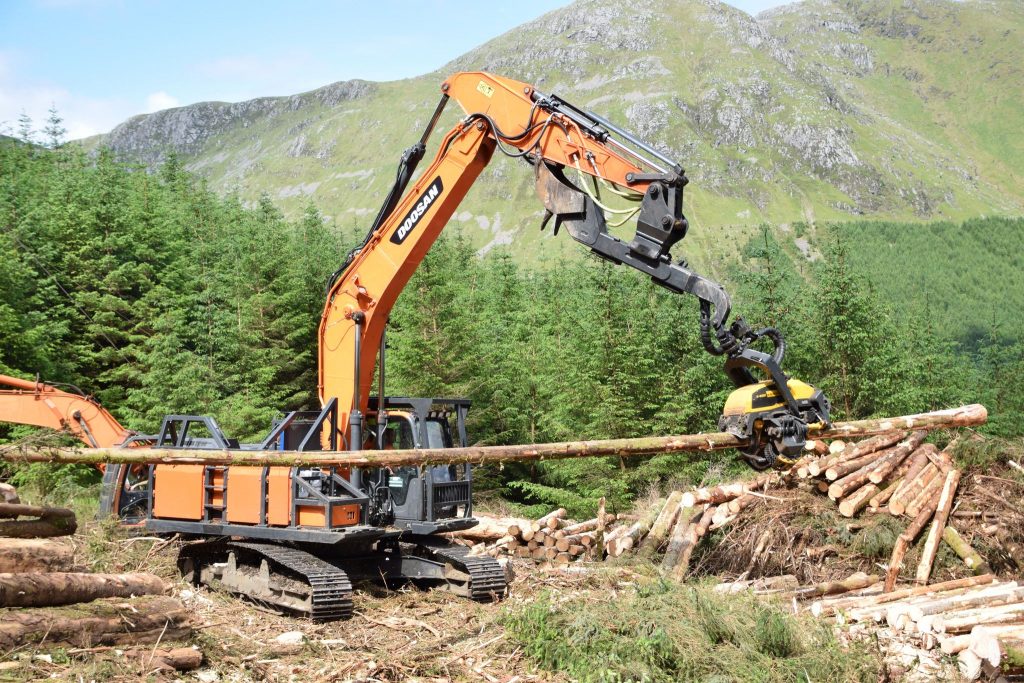

Robert showed how the Harvadig linkage converted the machine from a harvester to an excavator, a simple but ingenious system whereby the transformation took mere seconds. He then demonstrated using the bucket to move the large pile of brash that had gathered during processing.
I asked Robert why he had chosen the Ponsse harvesting head:
“I used a H8 HD on a Tigercat 855 four years previously. I found it to be a reliable harvesting head with a precise measuring system so I had no hesitation in buying another one. Again I am really pleased with the overall performance and reliability of this new head. It is good and strong and the computer system is very easy to navigate – I would happily recommend the H8 to others.”
While watching Robert on the harvester I saw Duncan head up to where the choker men were working; although he is a few years older than me, it was impressive to see the how quickly he ascended the steep mountainside. I don’t know of many young people who would have kept up with him and Robert informed us that he still puts in full shifts on the chainsaw!
Louis and Ruairidh Johnstone
Our next visit was to Spean Bridge to meet another father and son team, Louis and Ruairidh Johnstone, who were working on a private forestry estate nearby. The site was reasonably flat, but it was quite peaty and soft underfoot. Louis was operating a Tigercat 855C with a 2016 Ponsse H8 HD harvesting head.
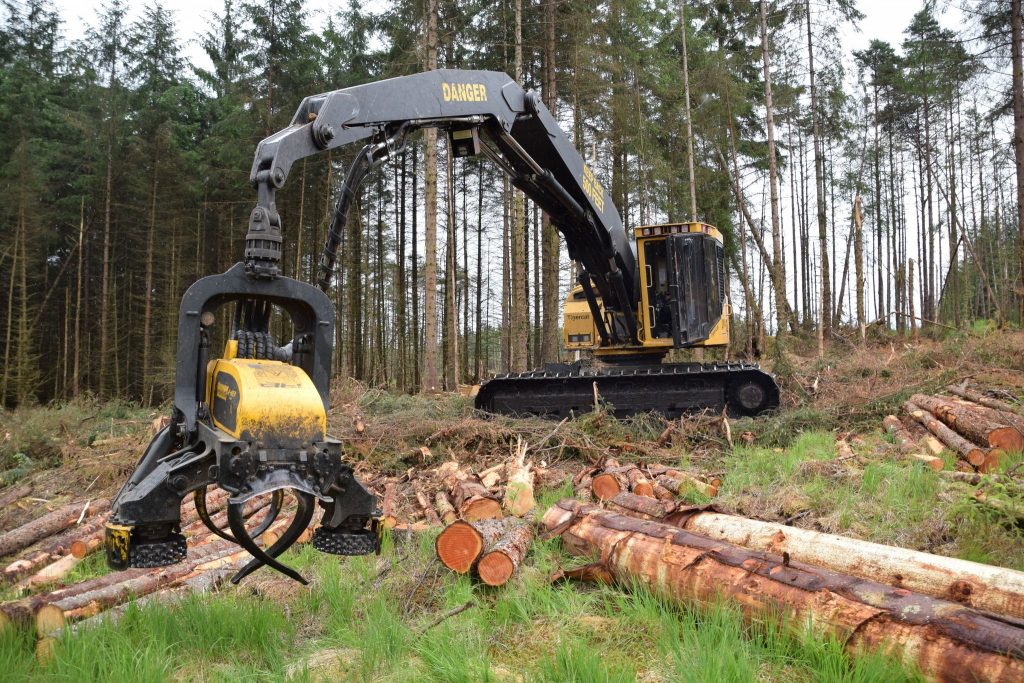

This machine had previously been owned by Duncan Gillies and was the very first H8 HD harvesting head off the production line. The 855C had the fixed base and the 9.5m reach crane without the extending dipper boom, and the combination worked incredibly well. Louis is a competent, fluent operator who is able to achieve good production from his harvester. The slewing power of the Tigercat was immense and the four year old harvesting head was in excellent condition and had stood up incredibly well to what was asked of it.
The timber being harvested was predominately Sitka Spruce with some Larch on the edge of the footpath which ran through the middle of the block. The Spruce was a real mixed bag with varying sized trees and pockets of check. This is a stand that would have benefited from being thinned a few years ago if the ground conditions had permitted it.
Louis has had very little downtime with the head: “It has been very reliable and works very well with the Tigercat. It is outstanding for harvesting heavily branched and edge trees, and the measuring is extremely accurate even in the roughest of conditions”.
The Tigercat was manufactured in 2008 and is fitted with the Mercedes engine, which Louis has nothing but praise for. It took Ponsse roughly a week to install and set up the head and computer system in 2016.
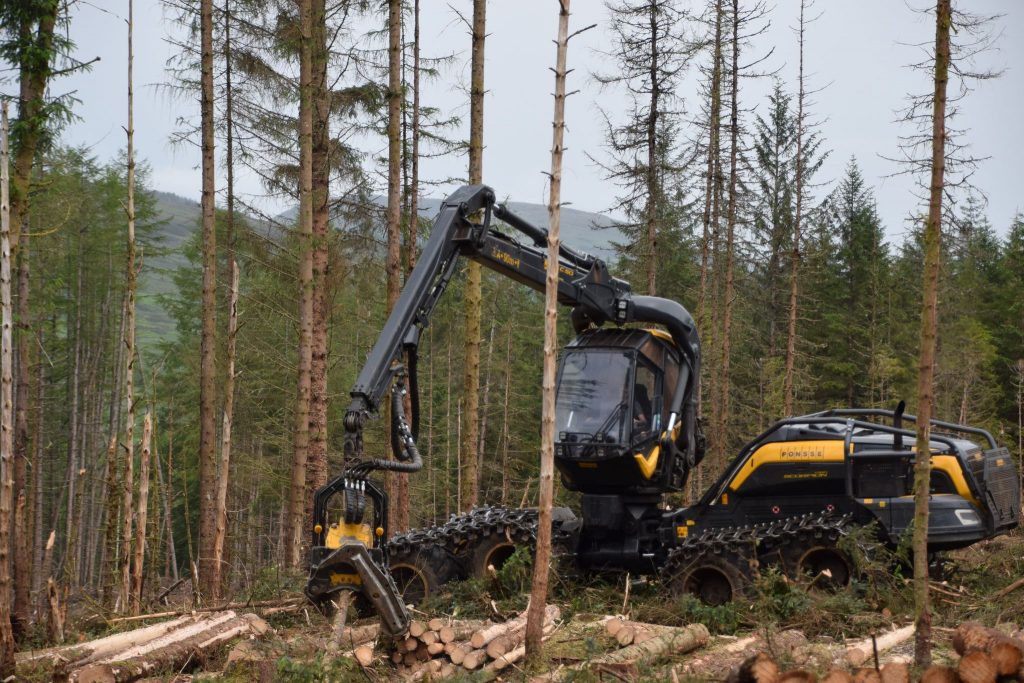

Louis had another two machines working on this site: a 2015 PONSSE Scorpion King & a very tidy 2007 Ponsse Buffalo with 26500 Hrs on it – Louis pride and joy.
Duncan Gillies
Our final visit of the day took us back down towards Oban to see Duncan Gillies Jr., who was in the process of finishing a clearfell.
Duncan was on a steep and challenging site for both the harvester and forwarder. There were a lot of rocky outcrops that had to be negotiated around and the harvesting would have taken some careful planning to maintain productivity for the forwarder operator.
Duncan had a levelling Tigercat LH 855D with the Ponsse H8 HD harvesting head – the second of the two H8 HD heads in the UK – and a Komatsu 895 forwarder on site.
Once again the timber was Sitka Spruce and there were some bloody big trees to be harvested; they were edge trees next to a stream, yet the 12m reach of the Tigercat with the powerful boom and harvesting head made short work of them. One of the trees harvested had a volume of 4.2m³ and Duncan harvested 30m³ in just over half an hour while we were watching.
This head is a little over a year old and Duncan has been delighted with his purchase so far.
“The head has worked great from new and I haven’t had any problems with it at all – the computer system is straightforward and very easy to use. It is the most consistent, smooth and fluent head I have used. It has a powerful saw motor, great feeding power and precision measuring.”
“It is great for not stripping the bark off the trees, especially in the spring when the sap is rising. This prevents the timber becoming very slippery which can be hazardous when forwarding and transporting to the sawmill.”
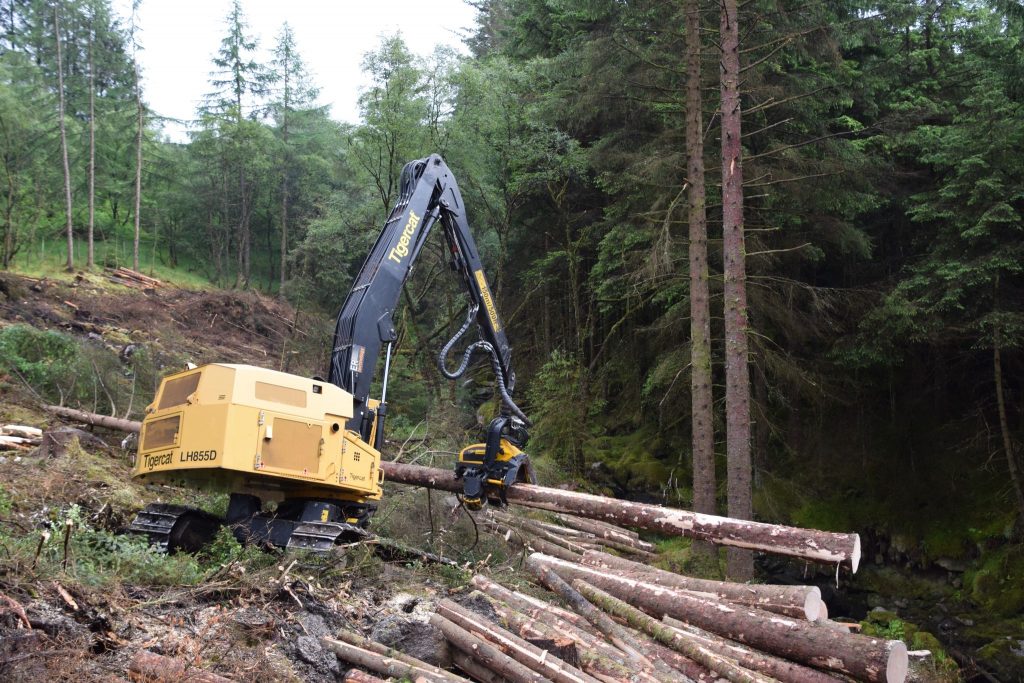

Duncan is a highly proficient operator who was productive, smooth and a pleasure to watch. Our first trip to the forest since the outbreak of Covid-19 has resulted in a really good day out and it was great to have three visits to harvesting operators who were all a credit to the industry.
We caught up with Craig Vernon a few days later to continue our visits, and the next contractor on Craig’s list was Calum Reid. Calum was working on a large clearfell a short drive from the far side of the Corran Ferry in Argyll. Calum and his team live a few hours away so they stay on site Monday to Friday.
Although it had been a beautiful day driving up, looming ahead were some dark angry skies with flashes of lightening and then the heavens opened. Luckily it was a passing storm that had cleared by the time we arrived on site, and getting out of the car I was relieved to feel a good breeze as otherwise the conditions would have been perfect for getting eaten alive by midges. My midge free cheerfulness didn’t last long however as the blood sucking clegs descended upon us like a biblical plague and I had forgotten that these, believe it or not, are even worse than midges.
Calum Reid
Calum has two Tigercat harvesters with Ponsse H8 harvesting heads: an LH845C and an H860C, with Calum operating the John Deere 1910 forwarder.
The site was typical of Argyll, steep in places with a lot of large granite rocks to negotiate around, and any plateaus had trees floating on top of bottomless peat bogs. It was a large clearfell consisting of Sitka Spruce with a large variation in sizes throughout; there were some nice straight trees averaging around 0.5m³ with blocks of check on the wet plateaus, as well as some small stunted trees averaging a lot less than 0.1 with pockets of windblow thrown in for good luck.
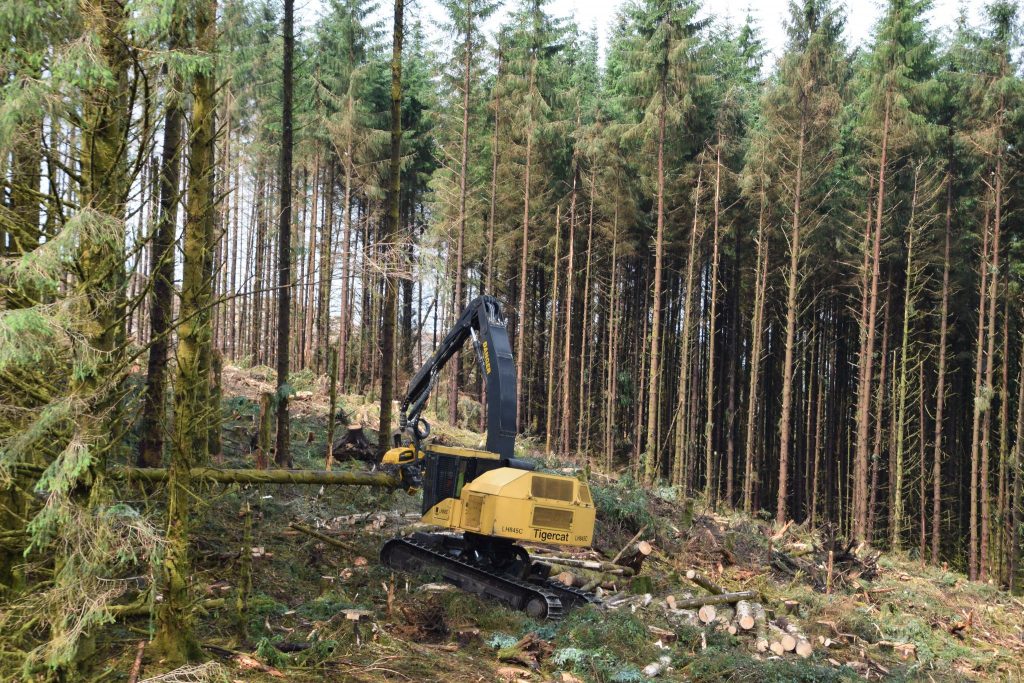

The top side of the site with downhill extraction had been completed and they were working below the road with uphill extraction. Such sites require a lot of careful planning by the harvester operators to identify the most effective extraction routes for the forwarder while minimising the environmental impact and protecting watercourses.
Calum’s brother Eddie operates the LH845C and his harvester included the newest Ponsse H8 head, which was fitted in April 2020 to a non-Ponsse base.
Eddie was working in some meaty timber and it quickly became clear that he is a skilled productive operator. With a career in forestry spanning 40 years, Eddie worked for his father’s forestry contracting business until he retired and then started working with Calum.
One advantage of working in Argyll is that there are usually not too many different sizes to cut; here, for example, they were cutting 3m chip, 2.5m pallet wood and 4.9m sawlogs and this makes life much easier for harvesting and forwarding.
Eddie was harvesting a short downhill drift towards a main watercourse and the Tigercat/Ponsse setup was perfect for this. As he got closer to the stream, he was felling the trees and slewing round to lay the full trees behind himself for processing well away from the running water. As a result, the forwarding became much easier while the steepest part was close to the stream and the timber was being processed on a gentler part of the slope.
I asked Eddie what he thought of his harvesting head:
“I have only used this new head for a couple of months but I am very pleased with it. The measuring is spot on and it is a compact and powerful head which does an excellent job of removing the branches but not skinning the trees even in sappy conditions. It is well built and strong but not overly heavy, which means it doesn’t upset the balance of the harvester when felling at full reach and is very stable for manoeuvring full trees to where you want to process them.”
We hadn’t been watching Eddie that long but he had harvested an impressive 35 tonnes.
Craig also notes that the H8 head is ideal for clear-fell or late large thinning’s and has now became the harvester head of choice with customers either on a purpose built Ponsse machine or as harvesting heads fitted to customers tracked base.
“Due to the H8`s excellent measuring and delimbing ability’s even under the most arduous conditions it out performs the competition every time!, one point every driver notices is its accuracy and ability to clean the trees first time”
We then set off to see Alistair Shearer, who was operating the Tigercat H860C on a wet plateau about 500m further down the site. It is strange ground as one minute you are scrambling over rocky outcrops and the next you hit a flat area, where if you stand still for any length of time your feet disappear into the peat bog.
The Tigercat had completed 27,000 hours from new and Alistair has been operating it for the last seven years.
Calum explained that this Tigercat was fitted with the wider undercarriage, which provides an excellent base for harvesting on these wet and soft areas.
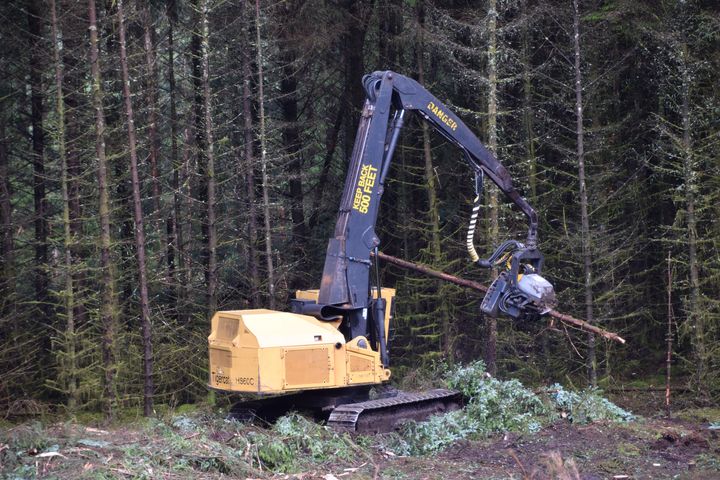

The head was in good condition but was in the older grey Ponsse colours – I was surprised to discover it was the very first H8 harvesting head fitted to a non Ponsse base back in 2008.
The original owner was Jimmy Graham from Annan who ran the Tigercat with a Ponsse H73E then changed it to a H8 in 2008 and to date the H8 has been harvesting timber for an incredible 22,000 hours. This figure is remarkable for a harvesting head that has spent all of its life on a Tigercat base and it is still an effective and reliable harvesting head that continues to give excellent production.
After watching Alistair for a while it was obvious he is another steady and competent operator who looks after his machine and presents the timber well.
It was early afternoon when we bid our farewells to Calum, Eddie and Alistair, but instead of heading straight home Craig discovered that Duncan Gillies Jr. had moved to a new site and, as the weather was better than our last visit, suggested that we visit him en route. Duncan was working a few miles from Ballachulish on the largest volume job he had undertaken to date.
He had harvested a few hundred tonnes when we arrived and it was another steep awkward site, with a few thousand tonnes at the back that would have to be skylined.


Duncan was harvesting the trees parallel to the road so that an excavator could level along the front for a stacking area, therefore allowing the forwarder to unload without having to travel on the forest road.
The timber was yielding a high log content and was good and straight with fairly light branches.
Watching Duncan was a pleasure (no midges or clegs to contend with) – the Ponsse H8 HD was eating the trees and, in combination with the slew power and lift of the Tigercat in the heavy timber, it was remarkably productive.
In all honesty, this was the most productive setup I have ever witnessed harvesting and this can be attributed to a first rate operator at the helm.
The head on Duncan’s harvester hardly is very steady with minimal swing when harvesting, which is testament to a smooth operator, and this keeps the timber stacks tidy for the forwarder.


We left soon afterwards as Craig’s next appointment was in Campbeltown, a few hours’ drive away.
This had been a tremendous two days seeing the Ponsse H8 heads on the Tigercat and Doosan excavator bases – the quality of the work and skill levels of all the operators we visited was a pleasure to observe.
Check with your local Ponsse dealer for some of the tempting packages on offer for fitting new harvesting heads onto used excavators.
Forest Machine Magazine is written and edited by a forest professional with over 40 years hands on experience. We are dedicated to keeping you informed with all the latest news, views and reviews from our industry.
To support us you can subscribe to our bi-monthly magazine which is delivered to your door from only £30 per year.
Subscribe here

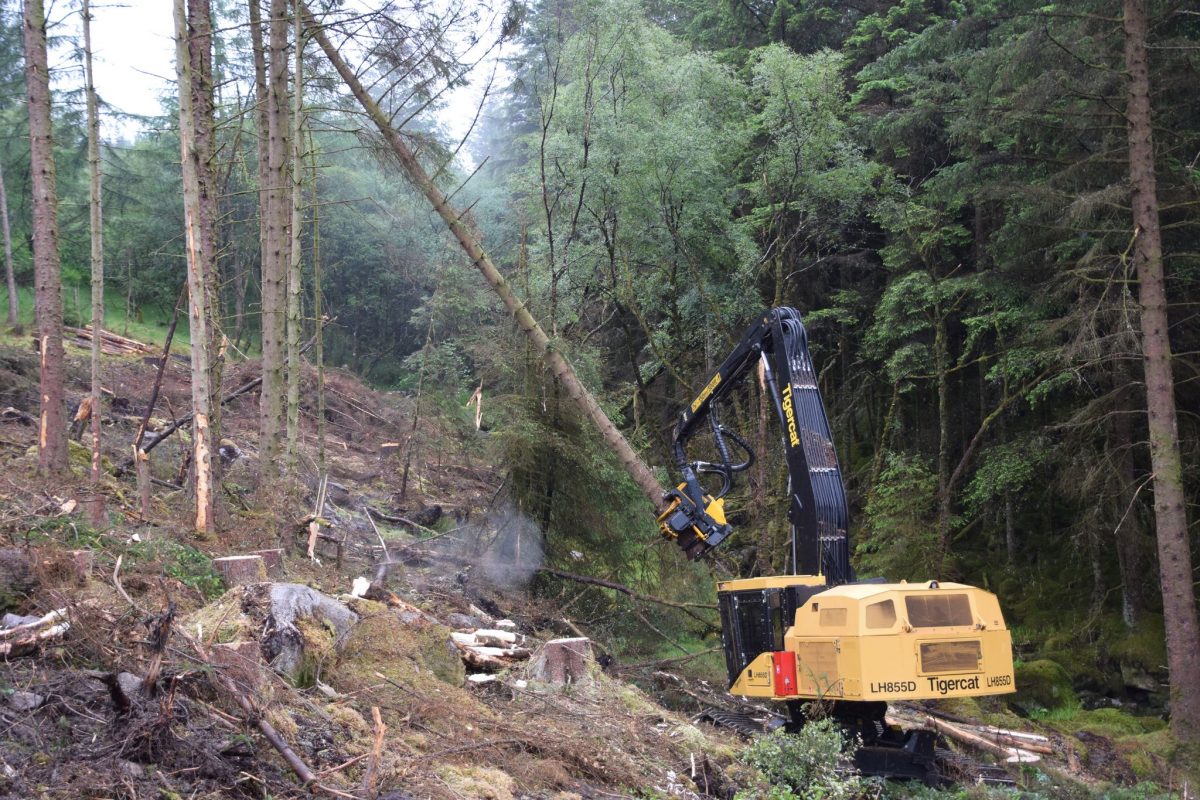
Excelente explicación. Enseño Ingeniería Forestal en México y me parece que lo mostrado en esta revista nos sirve mucho para ver otras formas de llevar a cabo labores silvícolas. Agradezco mucho su publicación y confieso ser ‘fan’ de su revista. Continúen así.